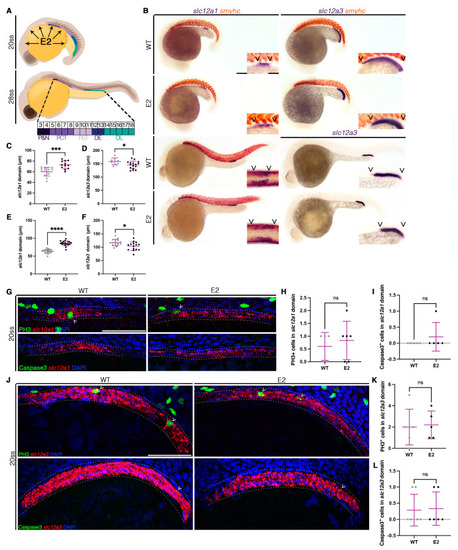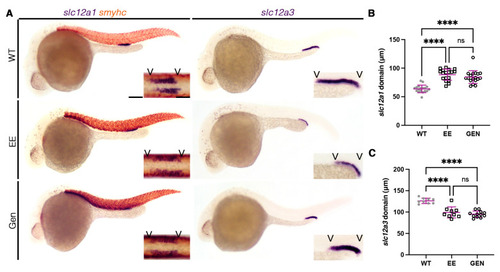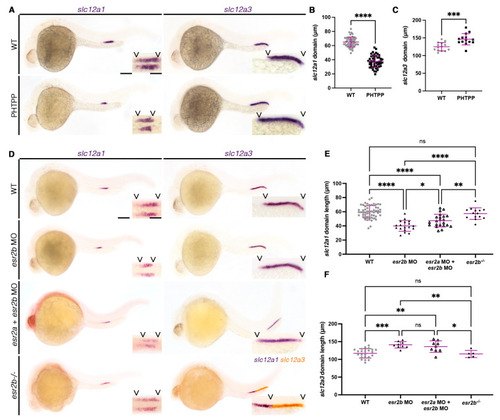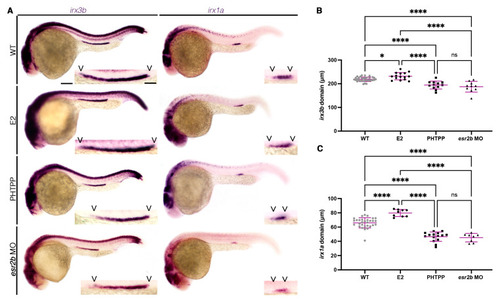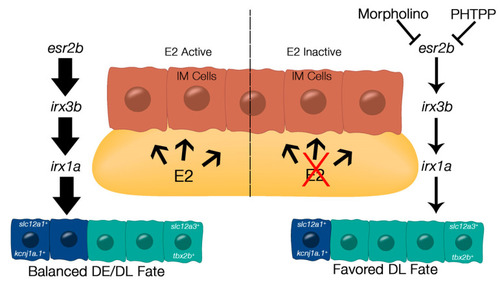- Title
-
Estrogen Signaling Influences Nephron Segmentation of the Zebrafish Embryonic Kidney
- Authors
- Wesselman, H.M., Gatz, A.E., Pfaff, M.R., Arceri, L., Wingert, R.A.
- Source
- Full text @ Cells
|
Exogenous E2 alters distal nephron segmentation independently of cell dynamics. (A) Schematic of nephrogenesis in a zebrafish from the early 20 ss (top) to the fully patterned 28 ss (bottom). 17β-estradiol (E2) is present in the yolk ball and diffuses to surrounding tissues. By 28 ss, the nephron is comprised of discrete segments with unique somite addresses: podocytes and neck (P&N, somites 3–4), proximal convoluted tubule (PCT, somites 5–8), proximal straight tubule (PST, somites 9–11), distal early (DE, somites 12–13), and distal late (DL, somites 14–18). (B) 20 ss (top two rows) and 28 ss (bottom two rows) WT control animals treated with DMSO as a vehicle control, and siblings treated with 20 µM of E2 from the shield stage to 24 hpf, stained via WISH for the DE marker (slc12a1, left) or the DL marker (slc12a3, right) with the somite marker (smyhc). Scale bar = 100 µm for lower magnification, scale bar = 50 µm for higher magnification. (C,D) DE and DL domain lengths at 20 ss in micrometers. (E,F) DE and DL domain lengths at 28 ss in micrometers. (G) The 20 ss WT (left) and 20 µM E2 (right) nephrons (outlined with dotted line) stained for the DE (slc12a1) via FISH and proliferating (PH3, top) or apoptotic (Caspase3, bottom) cells via immunofluorescence. Arrow heads denote double-positive cells. Scale bar = 50 µm. (H) Number of PH3-positive cells in the DE at the 20 ss. (I) Number of Caspase3-positive cells in the DE at the 20 ss. (J) The 20 ss WT (left) and 20 µM E2 (right) nephrons (outlined with dotted lines) stained for the DL (slc12a3) via FISH and proliferating (PH3, top) or apoptotic (Caspase3, bottom) cells via immunofluorescence. Arrow heads denote double-positive cells. Scale bar = 50 µm. (K) Number of PH3-positive cells in the DL at the 20 ss. (L) Number of Caspase3-positive cells in the DL at the 20 ss. Data presented on graphs are represented as mean ± SD. * p < 0.05, *** p < 0.001, and **** p < 0.0001 (t-test). |
|
Xenoestrogens phenocopy E2 distal nephron segmentation phenotypes. (A) The 28 ss WT (top), 20 µM ethinylestradiol (EE, middle), or 20 µM genistein (GEN, bottom) treated animals stained via WISH for the DE marker (slc12a1) with the somite marker (smyhc) (left), or the DL marker (slc12a3) (right). Scale bar = 100 µm for lower magnification, scale bar = 50 µm for higher magnification. (B,C) DE and DL domain lengths at 28 ss in micrometers. Data presented on graphs are represented as mean ± SD. **** p < 0.0001 (ANOVA). |
|
Chemical and genetic inhibition of Esr2b results in altered distal segmentation. (A) The 28 ss WT (top) and 18 µM PHTPP (bottom) treated animals stained via WISH for the DE marker (slc12a1) (left) or the DL marker (slc12a3) (right). Scale bar = 100 µm for lower magnification, scale bar = 50 µm for higher magnification. (B,C) DE and DL domain lengths at 28 ss in micrometers. (D) The 28 ss WT (top), esr2b MO-injected (second row), esr2a and esr2b double-MO-injected (third row), and esr2b mutant (bottom row) animals stained via WISH for the DE marker (slc12a1) (left) or the DL marker (slc12a3) (right). Scale bar = 100 µm for lower magnification, scale bar = 50 µm for higher magnification. (E,F) DE and DL domain lengths at 28 ss in micrometers. Data presented on graphs are represented as mean ± SD. * p < 0.05, ** p < 0.01, *** p < 0.001, and **** p < 0.0001 (t-test or ANOVA). |
|
E2 signaling operates through Esr2b upstream of essential transcription factors to elicit distal nephron cell fate. (A) The 28 ss WT (top), 20 µM E2-treated (second row), 18 µM PHTPP-treated (third row), or esr2b MO-injected (bottom) animals stained via WISH for the transcription factor irx3b (left) and its downstream target irx1a (right). Scale bar = 100 µm for lower magnification, scale bar = 50 µm for higher magnification. (B,C) The irx3b and irx1a domain lengths at 28 ss in micrometers. Data presented on graphs are represented as mean ± SD. * p < 0.05 and **** p < 0.0001 (ANOVA). |
|
Proposed mechanism by which E2 signaling contributes to nephron segmentation. When E2 signaling is active (left), E2 diffuses from the yolk into the neighboring intermediate mesoderm (IM) cells. E2 binds to Esr2b, which activates irx3b and irx1a, ultimately resulting in balanced DE and DL fate. When E2 signaling is inactive (right) via morpholino knockdown or chemical inhibition by PHTPP, esr2b activity is diminished, as well as expression of downstream targets irx3b and irx1a, resulting in favored DL fate. |

